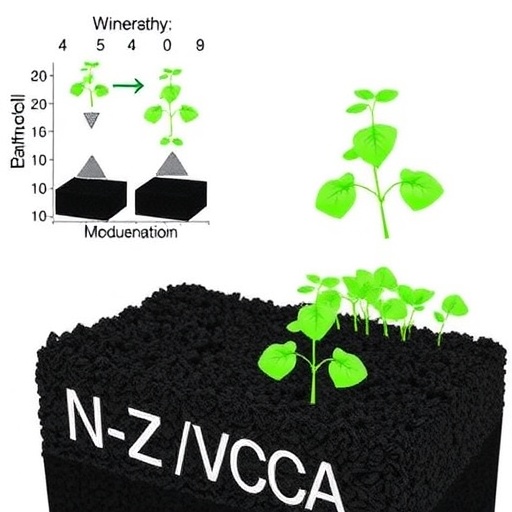In recent years, environmental contamination due to pharmaceutical residues has raised significant concerns among scientists and policymakers alike. One of the notable emerging pollutants is sulfamethoxazole (SMX), a widely used antibiotic in both human medicine and veterinary applications. As the prevalence of such pollutants increases, it becomes imperative to explore effective methods for their degradation and removal from the environment. A recent study led by Khan et al. has brought to light a promising approach utilizing a nanocomposite made from zero-valent copper (nZVCe) and biochar, which exhibits enhanced capabilities for degrading sulfamethoxazole.
The backdrop of this investigation highlights the grave risks posed by sulfamethoxazole, which can persist in aquatic environments and lead to adverse effects on aquatic life and ecosystems. Understanding the dynamics of these compounds is critical for developing effective remediation strategies. The study aims to achieve efficient degradation of SMX and, concurrently, evaluate the antioxidant and antimicrobial properties of the synthesized nZVCe/Biochar composite, which is gaining attention for its dual functionality.
At the heart of this research is the innovative composite material. Biochar, a carbon-rich product derived from biomass through pyrolysis, not only serves as a solid adsorbent but also improves the structural integrity of the synthesized composite. Zero-valent copper nanoparticles are integrated into the biochar matrix to capitalize on their high reactivity and catalytic potential. This hybrid material serves as both a sorbent for the pollutant and a catalyst that can facilitate chemical reactions leading to SMX degradation.
The method employed in synthesizing this composite is pivotal to its effectiveness. By carefully controlling the reaction parameters during the synthesis phase, the researchers were able to obtain a composite with optimal surface area and porosity. These physical characteristics are essential for maximizing interaction with sulfamethoxazole, thereby enhancing the degradation process. Characterization techniques such as scanning electron microscopy (SEM) and Fourier-transform infrared spectroscopy (FTIR) were employed to analyze the morphology and functional groups of the composite material, validating its suitability for environmental applications.
Experimental results showcased impressive capabilities of the nZVCe/Biochar composite in removing SMX from aqueous solutions. With increasing dosage of the composite, a remarkable efficiency in SMX degradation was observed, revealing its potential for real-world applications. The researchers meticulously documented various parameters affecting the degradation process, including factors like pH, initial concentration of SMX, and contact time. This comprehensive approach allowed for the identification of optimal conditions under which the composite performs best.
In addition to its capacity for degrading sulfamethoxazole, the study also sheds light on the antioxidant properties of the nZVCe/Biochar composite. Antioxidants play a vital role in neutralizing harmful free radicals in biological systems, which can cause oxidative stress and damage. By examining the composite’s antioxidant activity, the researchers aim to provide a dual-benefit narrative: not only does the material contribute to environmental remediation, but it also possesses potential health benefits. This intersection of environmental science and health extends the relevance of this research beyond conventional boundaries.
Moreover, antimicrobial assays demonstrated the effectiveness of the composite in inhibiting bacterial growth. The continual use of antibiotics, like SMX, can lead to the development of antibiotic-resistant bacteria, posing significant challenges to public health. By assessing the composite’s ability to thwart bacterial proliferation, the research supports a holistic approach to addressing the consequences of antibiotic use. This aspect makes it a pivotal player in the ongoing battle against antimicrobial resistance, paving the way for alternative strategies to improve public health.
The policy implications of the study’s findings cannot be understated. As regulatory frameworks evolve to address environmental pollution, findings such as those presented by Khan et al. provide substantial evidence for advocating the adoption of advanced materials that can effectively mitigate the impact of hazardous pollutants. Policymakers could leverage this research to develop guidelines and standards that promote sustainable practices and sustainable materials in environmental management.
An interesting aspect of the research is its potential for scalability and practical application. The usability of biochar, coupled with the ease of synthesizing nZVCe, suggests that it could be implemented in a variety of settings, ranging from municipal wastewater treatment facilities to agricultural runoff management. The adaptability of the composite to various environmental conditions could facilitate widespread implementation of such innovative remediation technologies.
In conclusion, the study by Khan et al. not only addresses the critical issue of sulfamethoxazole degradation but also opens avenues for further exploration of composite materials in environmental science. The dual functionality of the nZVCe/Biochar composite as both a pollutant degradant and a health-promoting agent emphasizes the intersection of environmental sustainability and public health. As research advances, it is essential for scientists and policymakers to collaborate, ensuring that effective strategies are deployed to tackle the pressing challenges posed by pharmaceutical contaminants in our ecosystems.
This research is a significant contribution to the field of environmental chemistry and offers a blueprint for future studies aimed at developing effective, sustainable solutions to combat pollution. The commitment to addressing environmental issues through innovative scientific approaches heralds a new era where researchers and industry professionals unite to foster a cleaner, healthier planet for future generations.
Subject of Research: Environmentally sustainable degradation of sulfamethoxazole using a nanocomposite.
Article Title: Efficient Degradation of Sulfamethoxazole and Assessment of Antioxidant and Antimicrobial Activities with nZVCe/Biochar Composite.
Article References:
Khan, S., Ahmad, A., Qadir, A. et al. Efficient Degradation of Sulfamethoxazole and Assessment of Antioxidant and Antimicrobial Activities with nZVCe/Biochar Composite.
Waste Biomass Valor (2025). https://doi.org/10.1007/s12649-025-03309-w
Image Credits: AI Generated
DOI: 10.1007/s12649-025-03309-w
Keywords: sulfamethoxazole degradation, nZVCe/Biochar composite, environmental sustainability, antioxidant activity, antimicrobial activity.




